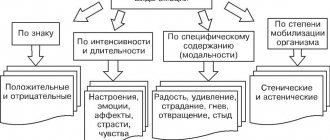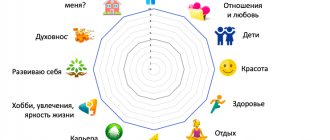As long as humanity has existed, it has been concerned with the question of emotions - what kind of phenomenon they are, why they arise and why they are so difficult to control, what meaning is contained in them and how many of them exist. Many fiction books are devoted to emotions, feelings and experiences of the soul, or touch on this topic in one way or another, and no less number of academic articles and studies have been written about them. At the moment, there are about a hundred scientific definitions of emotions, dozens of classifications and a number of theories regarding this vital phenomenon.
In this article we want to consider the adaptation model of emotions, which was developed by the American psychologist Robert Plutchik. Plutchik devoted many decades to research into the nature of emotions, as well as their evolutionary prerequisites and mechanisms, features and causes of defensive mental reactions, as well as psychodiagnostic details of human types. The fruit of all these scientific researches was the adaptation (or psychoevolutionary) model of emotions and the so-called Wheel of Emotions, which we will consider.
Let's understand the evolutionary background of our emotions better and get acquainted with Plutchik's model in detail.
Psychoevolutionary model of emotions
Plutchik's theory is based on an understanding of emotions as evolutionary mechanisms designed to ensure the best adaptation to external conditions and effective survival. In this paradigm, each emotion plays its role as a stimulator of adaptive behavior, and behind each emotion there is a natural impulse that must find its expression. These mechanisms are genetically determined and work automatically, moving us and helping us respond to external circumstances.
Thus, there are 8 primary, basic (or prototype) emotions:
- anger;
- fear;
- sadness;
- joy;
- disgust;
- astonishment;
- anticipation (also called expectation, and this is a joyful expectation);
- confidence.
At the same time, all of them can be combined into pairs of opposites (bipolar pairs): anger - fear, sadness - joy, disgust - surprise, anticipation (expectation) - trust.
Plutchik notes that all these emotions are observed in animals for the same evolutionary reasons. That is, the fact that emotions are inherent not only to homo sapiens, but also to other biological species, confirms that they have a deep vital meaning. Basic emotions and incentives drive animals, just like us, pushing them towards the most appropriate behavior in terms of adaptation to life.
To better understand what exactly the role of each of the basic emotions is, let's look at them in more detail. Plutchik decomposed the possible phenomena involved in the development of basic emotions into unique chains. In them, an external phenomenon (stimulus) entails a certain perception, a conclusion about it (cognition). This involves a certain experience (the emotion itself) that entails corresponding behavior. And all this is crowned by the effect or goal pursued by the individual in this psychoadaptive model. Plutchik presented all the elements of this system in the form of a table in his book Theories of Emotions, published in 1980. From it we see that:
- Fear (horror) is characteristic of a situation of threat (signal: “Danger!”), and its meaning lies in self-preservation.
- The emotion of anger (anger, rage) is a response to an obstacle (“Enemy”), and has the goal of destroying and eliminating this obstacle.
- Joy (ecstasy) arises at the sight of a potential partner, and generates desire for the purpose of reproduction.
- The loss of a significant individual causes sadness , grief, signaling abandonment, and encourages people to reintegrate (reunite with people, society).
- Acceptance and trust are characteristic of situations where we meet a member of our group, “our own” (recognizing him as a “friend”), and strive for accession, a closer connection with him.
- If we encounter a disgusting object, the natural reaction will be rejection and the emotion of disgust (hatred). The purpose of this process is to reject, reject that which can harm, poison or kill.
- Anticipation (joyful anticipation) is characteristic of situations where we are faced with something new, unknown to us, new territory. We are driven by interest and the desire to explore terra incognita: “What’s there?” Therefore, our subsequent actions come from the message to explore.
- And finally, surprise is a response to some new, unexpected or unknown object (“What is this?”) In such a situation, we are driven by the goal of determining our place relative to this object, finding guidelines and understanding the situation so as to know that we are safe regarding this object and can be calm.
Thus, it turns out that the main role of emotions is adaptive. They have evolved in both animals and humans to help them best cope with situations that arise. Depending on what the situation is and what its significance is for the individual, emotion allows one to act on the appropriate impulse, preserving the integrity of the body and well-being.
Here we can draw an interesting analogy with another point of view on the basic emotions inherent in all people. Let's take a closer look at it.
Basic emotions according to Ekman and how to recognize them
The seven emotions described by Paul Ekman are also called basic or fundamental emotions. This American psychologist and researcher gained great fame thanks to his work, in which he showed that facial expressions of various emotions are universal for all people, regardless of their cultural, racial and other affiliation. Published in 1978, the Facial Action Coding System (FACS) clearly and comprehensively demonstrates what micro-movements and facial expressions look like and offers a unique code for reading emotions.
The 7 universal emotions described by Ekman include:
- astonishment;
- fear;
- disgust;
- anger;
- joy;
- sadness;
- contempt.
Each of the 7 universal emotions is distinguished by its own specific micro-movements and micro-expressions of facial expressions, by which it is possible to accurately recognize it. You can study this aspect in detail in the article “Microexpressions,” but it is better to understand the entire system by reading Paul Ekman’s books “The Psychology of Emotions” and “The Psychology of Lies.”
We also draw your attention to the fact that for those who want to go even further in the ability to understand and “read” people, there is an online profiling training program. It is designed to teach you to get to know a person better, including leaving a psychological portrait and understanding real emotions, recognizing true and false ones. In addition, the program teaches skills to detect lies, stop manipulation and influence people. But let's continue.
As we can easily notice, the above emotions practically coincide with all the basic emotions identified by Plutchik. The exceptions are joyful anticipation (anticipation, interest) and trust, which are present in Plutchik’s system but absent in Ekman, and contempt. However, this fact does not devalue either theory.
Thus, Robert Plutchik's theory of emotions largely overlaps with other theories of basic emotions, in particular with the system of basic emotions, the facial microexpressions of which are clearly described in the works of Paul Ekman.
PLUS AND MINUS
Albert Ellis, the founder of rational emotive behavior therapy, once proposed a simple and convenient formula to describe how this “multiplication” occurs.
A x B = C,
where A is the activating event, B is our views and beliefs about the structure of the world, and C is the consequences (in our case, a complex emotion).
A complex emotion is determined by how we interpret this situation. Some people allow themselves to be overwhelmed by “negative emotions”, while others do not. And this suggests not so much that they have different physiological reactions, but rather that they experience these reactions differently.
Ellis divides beliefs into rational and irrational. The first are expressed in the form of wishes and preferences: “I like it when I succeed in what I do.” The second - in the form of absolute requirements: “I must achieve success in everything I undertake.” And the same emotion, when “multiplied” by a rational belief, turns out to be unpleasant, but quite bearable, and when “multiplied” by an irrational belief, it turns out to be torture.
Thus, a healthy negative emotion differs from an unhealthy one only in the belief that is applied to it.
POCKET GUIDE TO IRRATIONAL BELIEFS
You can recognize an irrational belief by several typical signs (watch your internal dialogue!)
An absolute requirement for yourself: “Everyone must always like me.”
Overgeneralization: “I never succeed.”
Dramatization: “This is unbearable! I won’t survive this!”
An absolute demand to the world: “This should not have happened! Never!"
Catastrophizing: “I didn’t submit the report on time - now I’ll definitely be fired, I won’t find another job, there won’t be any money, in a month I’ll be thrown out of the apartment...”
These things, by the way, love to hang out together.
Guilt - shame:
both guilt and shame originate in disgust and fear of rejection by the reference group. But if in the case of guilt, disgust is caused by a single act, then shame is a consequence of the spread of disgust to the person who did what he did not dare to do.
Annoyance - disappointment:
you are sad that fortune has suddenly turned its back on you - this is a completely healthy annoyance. But if you think that she had no right to do this to you and in general the world is cruel and criminally evil, then this is already the first step towards depression.
Anxiety - worry:
It is quite normal to feel anxious in anticipation of frightening events. But if you have convinced yourself that this event marks the divide between potential prosperity and the irreversible collapse of all life’s aspirations, then anxiety develops into anxiety.
Envy - jealousy:
sadness and anger from the fact that someone has something that would not hurt you is healthy envy, the engine of achievements. But as soon as you believe that something must necessarily belong exclusively to you, then your muscular black hands are strangling the girl.
The list of such pairs could be continued, but I think the main idea is clear: suffering is a consequence not of emotions, but of mishandling emotions. Healthy optimism easily becomes unhealthy as soon as a person begins to believe that “good things must happen to me, because they are good and I, the good one, really, really want them to happen.” And with the money that previously went to insurance, he now buys the book “The Secret...”. But this is a topic for another article.
Healthy? Share the article on VKontakte or Facebook in 1 click!
envynegative emotionspsychological attitudesdisappointmentjealousyshameanxietyfeelingsguiltexperimentsemotions
The Wheel of Emotions by Robert Plutchik
The Wheel of Emotions, created by Plutchik in 1980, represents emotions as a flower with eight petals. Each “petal” symbolizes one of the prototypical emotions, with opposing emotions located opposite each other. It turns out that polar emotions oppose and balance each other:
There can be a huge variety of different emotions and feelings, but they are all either basic emotions or their mixtures and derivatives. Thus, the eight emotions located outside the wheel, in the space between the petals, are a combination of the emotions of adjacent petals.
The wheel of emotions is made in color, which makes a lot of sense. Each emotion has its own color, and its saturation reflects the intensity of the experience, the brightness of the emotion. It turns out that in the very heart of the diagram there are the most vivid, intense emotions, in the second row (the second segment of the petals) the actual main (or basic) emotions, and then - a less pronounced version of each emotion.
It is worth noting that Plutchik himself did not call his graphic scheme a flower and did not use the term “petals.” In his works, he presented a model of a wheel and a model of a cone, which form one whole. If the Wheel of Emotions is an expanded two-dimensional diagram, then the cone is the same model, but in a collapsed three-dimensional form. The original graphical model clearly demonstrating both patterns and their relationship can be found in Plutchik's 2001 article [The Nature of Emotions, 2001]
To summarize: the main 8 emotions and their different degrees of intensity can be represented in the form of a circle, flower or wheel. This diagram, called the Wheel of Emotions, reflects both the intensity of each emotion through a color code and demonstrates the relationship of polarity or opposition of emotions. In addition to the basic emotions themselves, she indicates 8 derivatives formed by mixing two prototypical emotional states.
BEETLE IN A BOX
Ludwig Wittgenstein once proposed the following experiment: imagine that you and I each have a box. I ask: “What do you have in the box?” - and you answer: “Beetle.” I say: “That’s cool, I have a bug too.” And if we are both not very interested in insects, then we may well decide that our boxes contain the same bugs.
But if we want to check if this is true, what will we do? We’ll probably say: “I have a huge bug there, what about you?” - “I have a hefty one too.” It seems that one parameter coincided... But what does “hefty beetle” mean? For a person who has ever seen a South American Hercules beetle, and for a person who has never seen anything larger than a stag beetle, the concept of what a “hefty beetle” means will be very different. And it’s good that you can take the beetles out of the box, put them side by side and compare them. And then find a way to classify them.
Do you want your wish to come true? We invite you to a transformational psychological game that will speed up execution!
But what if beetles were found only in closed boxes, only their owners could see them, and then not entirely and out of the corner of their eye - how would we talk about them then? Introduced? That’s good, now there is no need to explain why the description, and even more so the classification of emotions, is one of the most disastrous undertakings in psychology.










